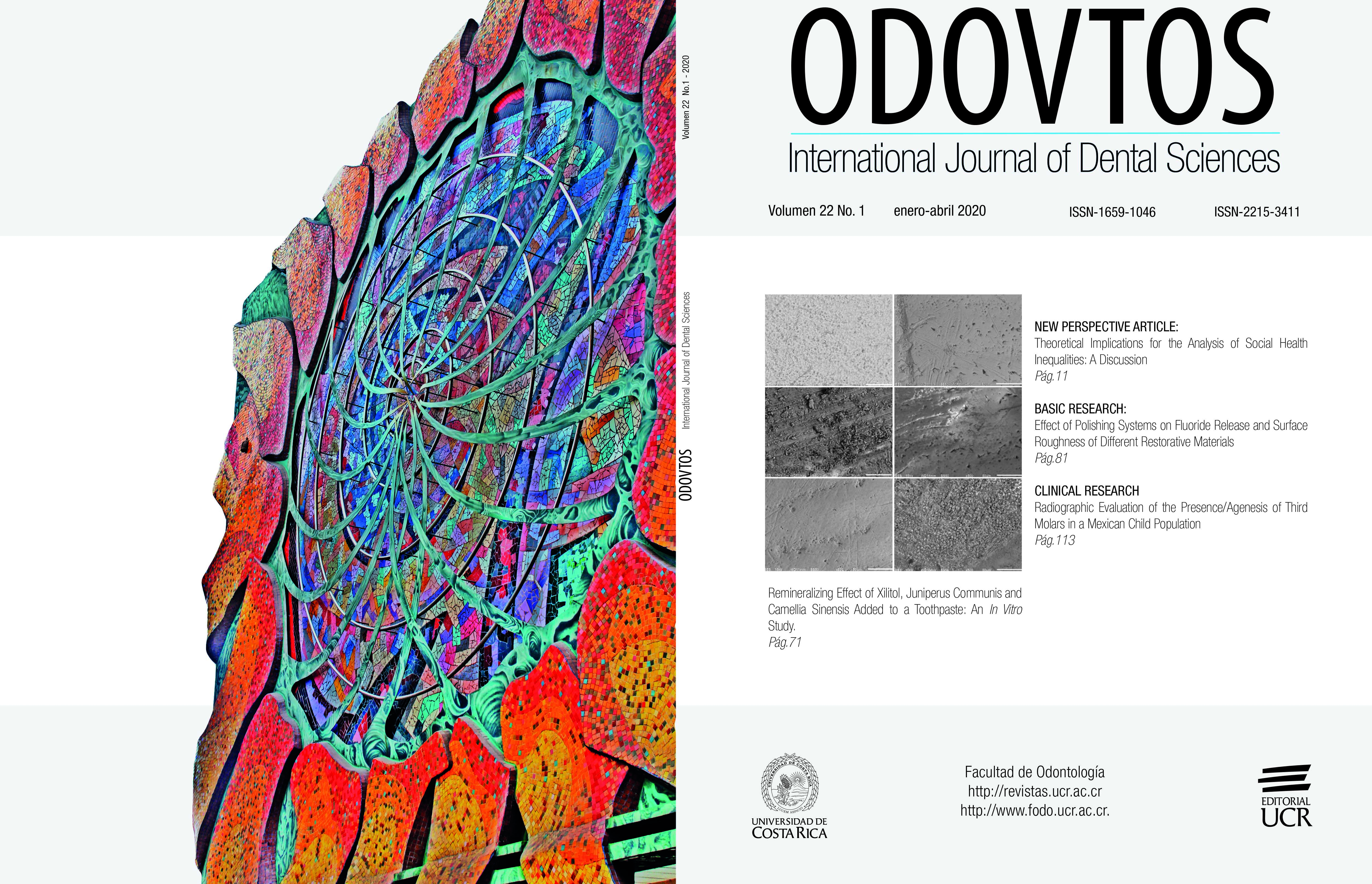Abstract
In the human being, third molar is the tooth that exhibits more variants during its embryologic development, usually causing diverse anomalies and discomfort when erupting to the oral cavity. It has been pointed out that the prevalence of third molar agenesis is between 9 to 37%. The aim of the present comparative cross-sectional study was to radiographically assess the presence/absence of third molar germs (G3M) in a sample of pediatric patients of Mexican origin. A total of 513 panoramic radiographs were analyzed from patients attending the Pediatric Dentistry Postgraduate Program ( San Luis Potosí University, México), during the years 2011 to 2017. Inclusion criteria were patients between 7 and 18 years old, any gender; children with antecedents of a third molar extraction, previous orthodontic treatment, or with an associated congenital or systemic condition were excluded. Total prevalence G3M agenesis was calculated. Then, statistical comparisons of agenesia proportions per dental quadrant, gender, and age group were performed. 245 panoramic radiographs corresponded to the female gender, while 268 belonged to the male gender. The total prevalence of G3M agenesia was estimated in nearly 56%, and the 7-8 years old group exhibited the highest proportion; however, when this age group was excluded from the analysis, such prevalence decreased to 27.3%. Both mandibular quadrants showed higher proportions of G3M agenesia. There were no significant differences between genders. The total prevalence reported in the present study was found to be well above regarding the international parameters. It is quite possible that lack of radiographic visualization of G3M had been inaccurate in some cases due to the common absence of calcification traces from those teeth during early ages (7-8 years old). The adjusted analysis provided a prevalence value more in line with the recognized standards in the dental literature.
References
Chappuzeau E., Cortés D. Anomalías de la dentición en desarrollo: Agenesias y supernumerarios. Rev Dent Chile. 2008; 99 (2): 3-8.
Marchena-Rodríguez L., Fernández-Ortega C. Etiología de las agenesias dentales. REDOE; 2015 [consultado 30 de enero de 2017]; Disponible en: http://www.redoe.com/ver.php?id=192
Botina C. J., Rodríguez L. F., Cepeda E. C., Zabala D. F., González-Colmenares G. Frecuencia de agenesias de terceros molares: Relación con el tamaño mandibular. Rev Nac Odontol. 2012; 8 (15): 52-6.
García-Hernández F.., Toro-Yagui O., Vega-Vidal M., Verdejo-Meneses M. Agenesia del tercer molar en jóvenes entre 14 y 20 años de edad, Antofagasta, Chile. Int J Morphol. 2008; 26 (4): 825-32.
Khan-Sujon M., Khursheed-Alam M., Abdul-Rahman S. Prevalence of third molar agenesis: Associated dental anomalies in non-syndromic 5923 patients. PLoS ONE. 2016; 11 (8): e0162070.
Silva-Meza R. Radiographic assessment of congenitally missing teeth in orthodontic patients. Int J Paediatr Dent. 2003; 13 (2): 112-6.
Herrera-Atoche J. R., Colomé-Ruiz G. E., Escoffié-Ramírez M. Agenesia de terceros molares, prevalencia, distribución y asociación con otras anomalías dentales. Int J Morphol. 2013; 31 (4): 1371-5.
Colorado-Pinillo M., Huitzil-Muñoz E. Agenesia de terceros molares en pacientes del Centro del estado de Veracruz. Rev TAME. 2015; 4 (11): 379-82.
Armand Lorié M., Legrá Silot E., Ramos de la Cruz M., Matos Armand F. Terceros molares retenidos. Rev Inf Cient. 2015; 92 (1): 995-1010.
Lucas G. V., Martínez S. E., Discacciati De Lértora S., Galiana A. V., Elizondo M. L. Detección radiográfica de anomalías y patologías dentarias y determinación del grado de desarrollo de los terceros molares en niños en entre 5 y 10 años. Comunicaciones Científicas y Tecnológicas 2008. Disponible en; http://www.unne.edu.ar/unnevieja/investigacion/com2008/M-006.pdf
Echeverri-Escobar J., Restrepo-Perdomo L. A., Vásquez-Palacio G., Pineda-Trujillo N., Isaza-Guzmán D. M., Manco-Guzmán H. A., Marín-Botero M. L. Agenesia dental: Epidemiología, clínica y genética en pacientes antioqueños. Av Odontoestomatol. 2013; 29 (3): 119-30.
Kolenc-Fusé F. J. Agenesias dentarias: en busca de las alteraciones genéticas responsables de la falta de desarrollo. Med Oral Patol Oral Cir Bucal. 2004; 9 (5): 385-95.
Calvo-Hernández I., Mourelle-Martínez M. R. Estudio clínico de las agenesias dentarias en una población infantil. Universidad Compútense de Madrid. Disponible en: http://eprints.ucm.es/19912/1/Isabel_Calvo_Hernández-Estudio_cl%C3%ADnico_de_las_agenesias_dentarias_en_una_población.pdf
Pamplona J. La mandíbula y el tercer molar (Tesis Doctoral). Universidad de Granada. Granada, España. 44, 1983.
Mursulí M., Rodríguez H., Landa L., Hernández M. Anomalías dentales. Gac Med Espirit. 2006; 8 (1): 366-88.
Prieto J. L. Third molar maturation and age assessment. Evolution and state of the art. Cuad Med Forense, 2008; 14 (51): 11-24.
Killinc G., Akkemik OK., Candan U., Evcil MS., Ellidokuz H. Agenesis of third molars among Turkish children between the ages of 12 and 18 years: A retrospective radiographic study. J Clin Pediatr Dent. 2017; 41 (3): 243-7.
Hegde S., Patosia A., Dixit U. Staging of third molar development in relation to chronological age of 5-16 year old Indian children. Forensic Sci Int. 2016; 269 (3): 63-9.
Ibarra A. Tesis Prevalencia de agenesia de terceros molares y estadio de Nolla en pacientes que acuden al CEOB; Centro de Estudios de Ortodoncia del Bajio. [Tesis doctoral en internet]. Citado el 30 de septiembre del 2013. 48 p. Disponible en: https://es.slideshare.net/alan_master/dr-alan-ibarra-prevalencia-de-agenesia-de-terceros-molares-y-estadio-de-nolla-en-pacientes-que-acuden-al-ceob
Bartolomè-Villar B., Barberia-Leache E., De Nova-García J., Beltri-Orta P. Desarrollo y agenesia del tercer molar en una población de niños y adolescentes españoles. Estudio de la agenesia (II). Odontol Pediatr. 1994; 3 (3): 107-12.

